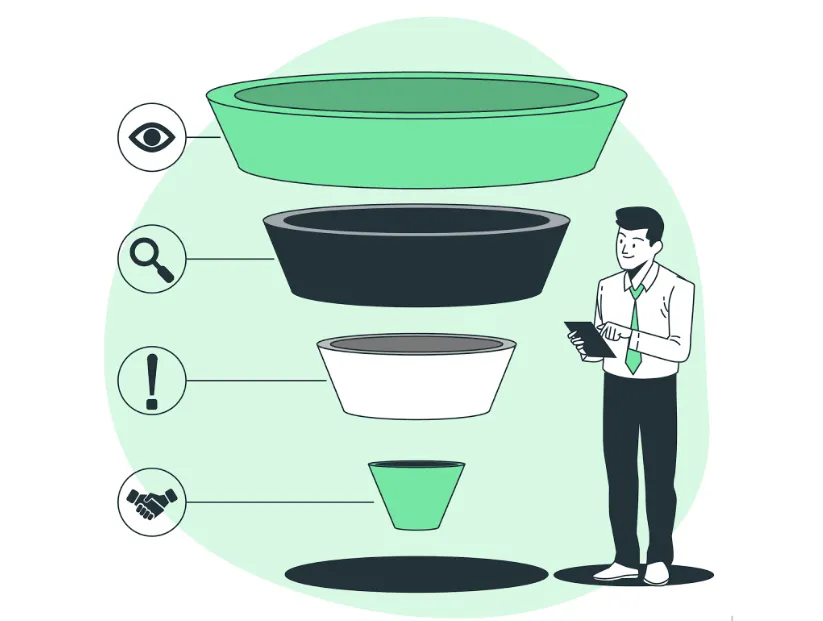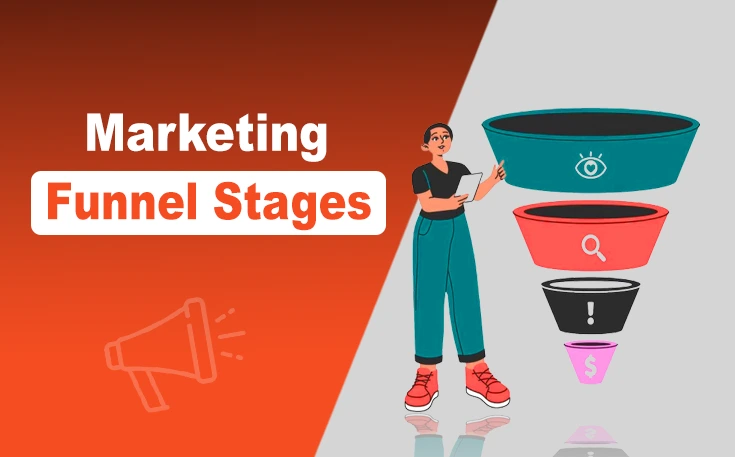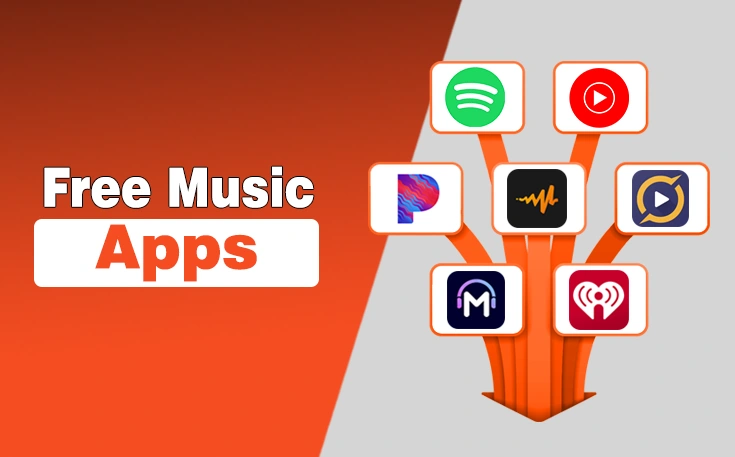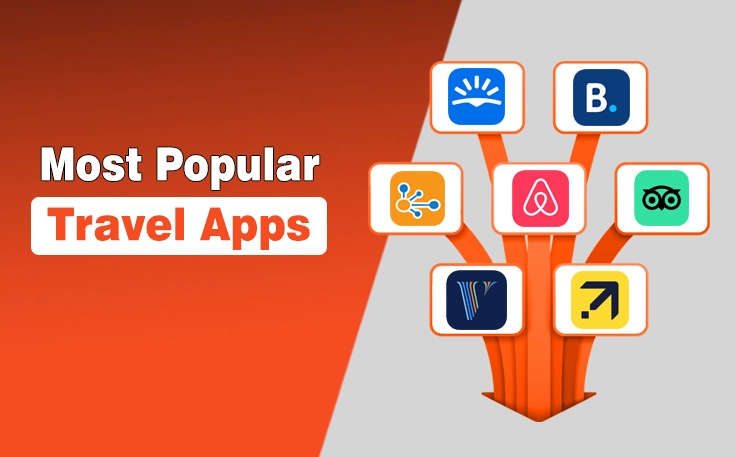Imagine having the ultimate guide that reveals exactly how strangers become your most loyal customers. That’s the magic of finding the right marketing funnel. Rather than making an educated guess about what your audience desires or praying that your advertising is on target, the funnel shows each step people take on their journey with your business.
Understand this process and you can command attention, stimulate curiosity, establish trust, and make sales—without losing time or money.
In this article, I will explain different marketing funnel stages and some strategies to get more customers.
Let’s start!
Marketing Funnel Explained
A marketing funnel is simply a neat way of illustrating how your customers transition from hearing about your brand to making a purchase. Think of an actual funnel—it’s large at the top and then becomes narrower towards the end. That’s roughly how your customers transition through this entire process.
In fact, there are different stages or types of marketing funnels. For instance:
- At the top-of-the-funnel (TOFU), you have a massive number of people who might be interested in what you’re offering.
- As they progress through the funnel, and get to the middle-of-the-funnel (MOFU), some drop off, and you’re left with a smaller but more interested group at each stage.
- At the bottom-of-the-funnel (BOFU), you have your actual customers—fewer in number but so much more valuable.
Mastering the marketing funnels is actually quite helpful in making your marketing campaign even more effective. It informs you where the potential customers might be dropping off, and you can tweak your methods to keep them engaged.
In order to actually master this, using the best SEO tools for agency is crucial. By using these tools, you can keep tabs on the source of your audience, how they engage with your products and content, and what you can do to optimize everything. Be sure to compare different tools before you select the one that works best for your business.

Marketing Funnel Stages Tips to Get More Customers
Capturing Attention: Mastering the Awareness Stage
The awareness stage is way up at the top of your funnel. This is where people first learn about your brand—perhaps from a social media post, a Google search, or an ad they came across.
Here, your main goal shouldn’t be to sell. You just want to meet people and show them how you can help with their problems. At the beginning of your funnel, it’s all about saying, ‘Hello, we exist!’ to as many people as possible.
Content that works extremely well at this level is blog posts on typical issues in your business, useful videos, entertaining but informative social media updates, and free downloads highlighting your expertise.
The goal should be to offer as much value as possible without worrying about what you get in return. For instance, a fitness trainer would post workout tips on Instagram and write useful articles on LinkedIn simply to grab people’s attention. Just keep in mind that people don’t want to buy anything at this stage—they just want to know you.
Sparking Curiosity: How to Excel at the Interest Stage
After they discover you’re around, the challenge is then piquing their interest so that they become interested in finding out more. It’s at this very point where you have to establish the connection and begin demonstrating what you have is special and why they should care.
At the interest stage, you can offer an e-book for free, a webinar, a mini-course, or even a quiz to guide people on what they require. Once you get their contact information, it gets easier to continue developing that relationship.
For instance, when you’re promoting productivity software, you could offer a free “Time Management Analysis” that lets them know where they’re spending time. For that, they provide you with their email address where you can contact them with more specific information.
Handling this stage effectively is important because this is your first opportunity to speak to potential customers directly.
Winning Minds: Strategies for the Consideration Stage
The consideration phase is where things get interesting. Here, your prospects know you and are seriously considering whether your offering is the right solution for them. They start comparing you to the competition deciding what sets you apart. And if they find you more interesting, they’re more likely to follow you on social media, download your guides, and get on your email list.
Your job here is to demonstrate why you’re the best option without being pushy. Case studies, product demos, comparison guides, and testimonials are perfect here. You’re basically building your case at this stage.
Just remember that your consideration stage is where your funnel strategy should really come into its own. You need to answer any concerns before they become dealbreakers and make yourself the go-to option. Keep in mind that individuals at this stage are conducting research, so giving them good, honest information builds trust.
Sealing the Deal: Perfecting Your Conversion Stage
This is the conversion process where leads turn into customers. Those people already know about you and what you offer, and they’re now very close to taking action.
Your goal here should be to make it highly convenient and accessible to purchase. This is your moment to create a relationship with your audience because they are interested in your company. They are willing to find out the goods and services that you have and what value they can gain from them.
To make this happen, you can use conversion tools like exclusive offers, free trial periods, money-back offers, and simple checkout procedures. The idea is to eliminate anything that could prevent someone from actually buying.
For example, ensure your product or service pages carefully explain everything with interesting descriptions, entertaining videos, and excellent photos. Monitor your checkout process to determine if people are experiencing payment issues or abandoning their carts for any other reason.
It is interesting to note that traditional marketing funnel frameworks break at conversion, but contemporary frameworks acknowledge that turning a customer into a repeat buyer and advocate is equally significant. That is why most contemporary conversion funnels encompass post-purchase phases such as retention and advocacy.
Boosting Your Funnel with Smart SEO Tactics
Your marketing funnel and SEO strategy need to be completely in sync. Various types of searches correspond to various stages in the funnel, and adapting your content to match that can significantly improve your outcomes.
To handle it well, try to post some general information that addresses the common questions in your industry. You want to aim for keywords people search for when starting out on a topic or issue.
At the consideration and interest stages, employ more specific keywords that show an individual is really searching for solutions. Phrases such as Top 10 [products], “how to choose the best [product]”, etc., clearly explain what people want at this stage.
For the conversion stage, go for keywords with a high buying intent, like keywords starting with “buy” “purchase”, “order”, “best price for”. Pages targeting these keywords must make buying as simple as possible.
An effective funnel can turn casual browsers into your repeat customers, and even help you save some money in the process. When you align your SEO planning with your customer funnel, you make sure that individuals find relevant content at each stage of the buying process.
Measuring Success to Know the Performance of Your Funnel
A marketing funnel by itself is only as impressive as your ability to measure and optimize it. Every step requires different metrics to measure how well it’s functioning.
During the awareness stage, look at metrics such as reach, impressions, site visits, and brand searches. These indicate the number of people who are discovering your brand.
At the interest and consideration phases, monitor metrics such as email opt-ins, downloads, website traffic, and returns. These indicate intent and activity.
For conversion, concentrate on average order value, cost per acquisition, and conversion rate. After purchase, measure customer lifetime value, repeat purchase rate, and referrals.
The secret to measuring your customer funnel performance is to find where folks fall off and then tweak everything for better results.
Conclusion
Getting the hang of the marketing funnel stages puts you in a better position to boost your business. Rather than just throwing out random marketing stuff, you can build a smooth system that takes people from learning about you to actually buying from you.
But you must remember to keep your funnel strategy focused on the customer. It’s all about solving their problems and adding value at every step instead of just pushing for a sale. When you genuinely help people make smart choices, the conversions will just flow in.





